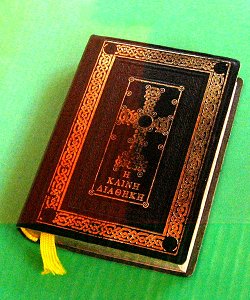
 |
Bible: The New Testament |
|
| Ancient Greek original text and translations presented by the Classics Reader |
|
 |
 |
|
Please note: The above is only a Java applet, in which features such as “find word” are not functional. To obtain the stand-alone program in which such functions have been implemented and are working, as well as to see what else will be included in the future, go to the downloading page. |
 The New Testament (Greek edition) |
The
New
Testament is the second part of the Bible, the holy book of
Christianity. The first part of the Bible is known as Old Testament, or
the Jewish Bible, the books of which were written in ancient Hebrew. In
contrast, the New Testament was written in Greek; specifically, in Koine
Greek, the vernacular Greek dialect of the time. Why was Greek chosen as the language in which the New Testament was written? The reason is that, during the 1st and 2nd centuries AD, Greek was the “lingua franca” (the “common language”) of the Mediterranean world. If today an author wants to reach an as wide readership as possible, he or she will choose to write in English; at the time the books of the N.T. were written, Greek was playing that role. The reason for Greek playing the role of lingua franca was that Alexander’s conquests had helped spread the Greek culture in vast expanses of the eastern Mediterranean world, and thus knowledge of the Greek language was perceived as an asset of good education. Similarly, the Romans, who had conquered Greece by the 2nd C. BC, were “captured” by the Greek culture, and would hire Greek teachers to teach Greek to their youth. |
The New Testament starts with the four gospels, by Matthew, Mark, Luke, and John. These occupy a little less than half of the N.T., with Matthew and Luke being the longest ones. The gospels are followed by the Acts (of the Apostles, perhaps written by Luke), which narrates the deeds of Christ’s Apostles after Christ’s crucifixion; the Pauline Epistles (letters that Apostle Paul sent to several people in the Roman empire); a few more epistles (by James, Peter, John, and Jude); and the Revelation, written by Apostle John, son of Zebedee (same as the author of the 4th gospel), while he was on the island of Patmos.
The original Greek text is presented in Classics
Reader in a way that facilitates its studying: it is broken down
into small, meaningful phrases on the left page, so that one can easily
follow their translation on the right page. Young’s Literal Translation
helps even further, often sacrificing proper syntax in English in order
to preserve the order of words in Greek, together with their tenses,
aspects, etc. |
Known Issues regarding the Classics Reader Why is the text printed in this funny fashion, with letters appearing to “push” each other, until they all fall in place? That behavior is observed only in the Java applet of this page (not in the stand-alone program), and occurs because each letter is an image (a GIF). Web browsers (as well as the Java engine that’s responsible for displaying those GIFs on your screen) show images in a random order when they have to show more than one of them on the same page. Thus, character images appear on a first-loaded-first-displayed basis, until they are all in place. However, once an image is loaded it doesn’t need to be reloaded when re-printed, unless you jump out of this page; that’s why this funny behavior diminishes as you scroll down the text. However, this problem does not exist in the stand-alone program, because that one runs locally on your computer. Why is this weird font used for classical texts? Why does the circumflex look strange? Why don’t the letters look more like the usual ancient Greek letters of classical literature or the Bible? The font employed by Classics Reader is the standard Times Roman font used in Greek literature in Greece, to print both modern and classical texts. The circumflex is correct according to that tradition. The reader who wonders about this issue is probably more familiar with fonts used in western Europe and the USA to print classical and biblical Greek texts. There is no reason why the latter tradition should be preferred over the former. Note that west European and American fonts for ancient Greek texts cannot be “closer to the original”, because ancient texts were hand-written by scribes, so their appearance depended on the scribe’s handwriting; it was only relatively recently that typography standardized what is now recognized as “ancient Greek font” in the West. Sometimes, when using the scrollbars of the browser (not the Classics Reader’s own ones), some line or lines appear misprinted in the Reader’s text. This is a problem created by the browser, and it appears
occasionally when scrolling up or down, while a Java applet
attempts to paint in its own rectangle. To refresh the text,
click on the Chapter selection (the middle of the three
choice-boxes) and select the same chapter that you are currently
reading. Once again, this problem does not exist in the
stand-alone program. |
For comments, suggestions, or other correspondence please contact the author of this page. Click here to email to him.